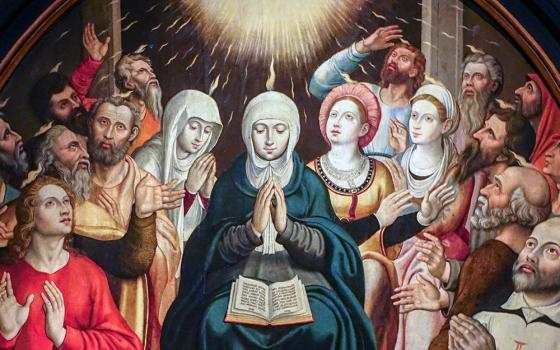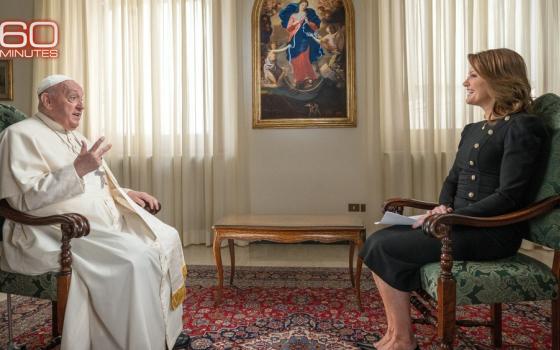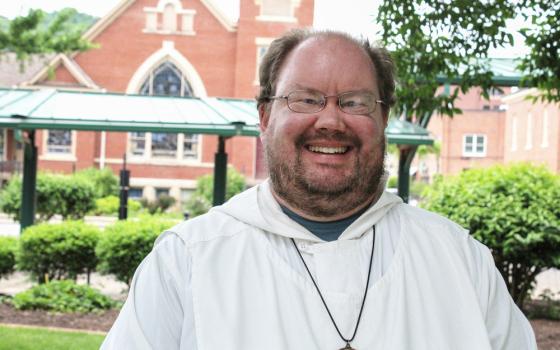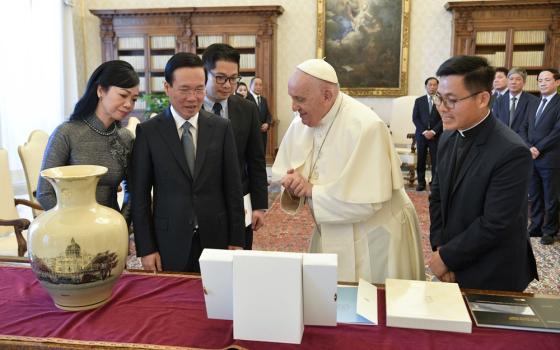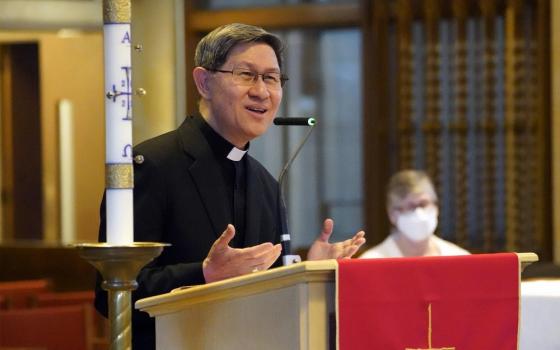
"Two Visionary Women" by Monique Tarabeh (Monique Tarabeh)
"Have you understood all these things?" Jesus asked. "Yes," they replied. He said to them, "Therefore every teacher of the law who has become a disciple in the kingdom of heaven is like the owner of a house who brings out of his storeroom new treasures as well as old" (Matthew 3:51-52).
As I sit and ponder, the word "synodality" keeps resonating in my thoughts, urging me to dig deeper. Intrigued by its roots, I turn to Google to understand its essence. "Synodos," a Greek term composed of sún (with) and hodós (way, path), holds deep significance in the church's tradition, symbolizing the concept of walking together on a shared journey.
Recent gatherings I've attended revolved around collaboration, focusing on the future of religious life. This contemplation sparks a question: Is synodality a new term in religious life?
The concept of synodality is rooted in the belief that every member of a religious community has a unique perspective and a valuable contribution to make. By bringing everyone together and working toward a common goal, religious communities can create a shared vision that reflects the needs and aspirations of the group as a whole.
Synodality is not a new concept, but it has taken on new significance in recent years as religious communities face new challenges and opportunities. By embracing synodality, communities can work together to address these challenges and seize these opportunities, creating a more vibrant and resilient community in the process.
While we are contemplating this topic, an interesting story comes to mind from the history of two congregations. In 1838, two visionary women met in Rome, and their encounter set in motion a narrative that still holds relevance today. This story highlights the fact that synodality is not merely a theoretical concept, but is rooted in the real-life experiences of people who strived to find a collaborative path forward.
During my time in Rome, one of our sisters graciously took me on a journey to trace the footsteps of St. Mary Euphrasia Pelletier, the founder of my congregation, Our Lady of Charity of the Good Shepherd.
Our exploration led us to Trinita dei Monti, the residence of Madeleine Sophie Barat, founder of the Society of the Sacred Heart. The location still housed a French school. Puzzled, I wondered about the connection between this school of the Sacred Heart and Mary Euphrasia's legacy. It was then that my companion shared a captivating story.
The Religious of the Sacred Heart in France knew a noblewoman yearning for solace amid the tumultuous trials of life. They dispatched her to seek refuge and guidance from Mary Euphrasia. Upon her return, the noblewoman expressed her heartfelt gratitude, having discovered in Mary Euphrasia a compassionate confidante who truly understood her heart. Sophie Barat had known Mary Euphrasia since that time.
When Sophie learned of Mary Euphrasia's presence in Rome, she extended an invitation for her to address the girls at the school of the Sacred Heart. Initially, Mary Euphrasia was hesitant due to her reluctance to engage with high society. She eventually relented, moved by Sophie's earnest plea. As recounted in the book Good Shepherd's Fold, by Anne Boardman, after their visit concluded, both women humbly knelt to receive blessings from one another.
Of this visit, Mary Euphrasia wrote: "I shall always preserve the most delightful memories of the Trinita dei Monti and of the worthy Superior of the House. What a religious spirit! What perfection in all those Ladies!"
Mary Euphrasia's visit to the Sacred Heart convent of Trinita dei Monti demonstrates the warm relationship that has always existed between these two great religious congregations, one serving and educating children favored by birth, wealth and social advantages; the other dedicated to the welfare of women and girls whose problems bring them into conflict with God and society. Both congregations were the presence of the heart of God, empowering, restoring and upholding dignity for those they serve.
What a moment of grace unfolding, revealing the profound ways in which we can shape the future of religious life. It unveils a magnificent vision of global sisterhood and collaboration, beckoning us to explore the boundless possibilities of unity and cooperation across diverse religious landscapes.
Advertisement
In this vision, the future of religious life is not confined to the walls of individual congregations or specific practices. Rather, it extends to a realm where collaboration becomes the driving force for the mission. Building bridges, breaking down barriers and creating a shared sense of purpose are identified as essential components of this collective vision. It signals a departure from isolationist approaches and urges religious communities to become active contributors to the overall well-being of humanity.
In the narrative of Mary Euphrasia Pelletier and Madeleine Sophie Barat, we witness a profound embodiment of synodality — a collaborative journey guided by the heart. Their story serves as a beacon, illuminating the path toward a future where collaboration becomes the cornerstone of religious life. By listening, seeing, thinking, and responding with the heart, they forged a bond of sisterhood that transcended boundaries and empowered them to create meaningful change in the world.
Listening with the ear of the heart, they embraced an intuitive, sacred listening that fostered genuine discernment and mindfulness. Their capacity to hear beyond the surface noise allowed them to perceive the whispers of the Spirit, guiding them toward a deeper presence. Similarly, seeing with the heart enabled them to perceive the hidden truths and intangible realities that lay beyond mere appearances. Through this intuitive vision, they cultivated compassion and a renewed sense of purpose.
Thinking with the heart, Mary Euphrasia and Sophie Barat embraced a wisdom that transcended mere logic, finding meaning and understanding in building a future where religious help religious. Their heart-centered reasoning fostered creativity, resilience and transcendence, guiding them through life's challenges with grace and conviction. Finally, responding with heart, they dared to engage in a co-creative process with God, listening with openness and responding with authenticity.
As we reflect on their journey, we are reminded of the transformative power of synodality — a journey guided by the heart, where collaboration becomes a sacred dance of listening, seeing, thinking and responding. In this vision, the future of religious life is not confined to the walls of individual congregations but extends to a realm where unity and cooperation become the driving forces for mission and purpose. Let us heed the call to synodality, embracing the spiritual capacities of the heart as we journey together toward a future filled with hope, compassion and communion — and one bringing out of our history new treasures as well as old.


